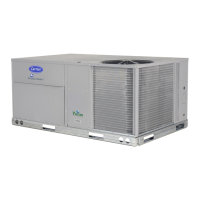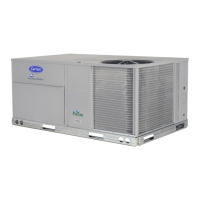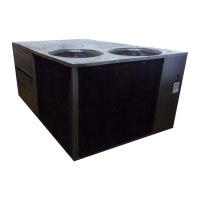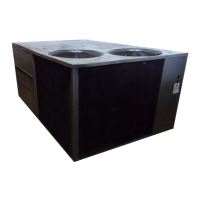7
CFM to the application requirements. The VFD’s settings should
not be used for adjusting fan performance. Specific VFD
information can be found in Appendix C.
IMPORTANT: The Supply Fan Maximum Speed (FS.MX) RPM
must not produce a supply CFM that is lower than the minimum
CFM allowed in the product data for heating and cooling.
For belt drive units with a power exhaust option, the controls
require an accurate supply duct CFM at the unit design point where
the indoor fan will run at the Supply Fan Maximum Speed
(FS.MX) for proper operation. The supply duct CFM is configured
by the Indoor Fan Max Speed CFM
(Configuration
ECON
IDF.C). Default values for Indoor Fan
Max Speed CFM (IDF.C) are generally set per chassis and should
be changed per application. It is preferred to use the supply duct
CFM from an air balance report to configure the Indoor Fan Max
Speed CFM (IDF.C). If an air balance report is not available, then
use the fan tables to determine Fan Max Speed CFM (IDF.C).
When using the fan tables to determine Fan Max Speed CFM
(IDF.C) set Economizer Position Test (Service
Test
INDP
ECON) to 0 (Economizer Damper Closed) and
Indoor Fan Speed Test (Service Test
FANS
F. S P D ) equal to
Supply Fan Maximum Speed (FS.MX). Measure the supply to
return duct static pressure difference and indoor fan RPM. Make
correction to static pressure for all options installed in the unit per
the accessory pressure drop table. Determine Indoor Fan Max
Speed CFM (IDF.C) on the fan table where the corrected static
pressure and RPM cross.
Condenser Fans and Motors
Condenser fans and motors are factory set.
Return--Air Filters
Check that correct filters are installed in filter tracks (see Physical
Data table in Installation Instructions). Do not operate unit without
return-air filters.
Outdoor--Air Inlet Screens
Outdoor-air inlet screens must be in place before operating unit.
Accessory Installation
Check to make sure that all accessories including space thermostats
and sensors have been installed and wired as required by the
instructions and unit wiring diagrams.
Orifice Change (48HC)
This unit is factory assembled for heating operation using natural
gas at an elevation from sea level to 2000 ft.
Use accessory high altitude kit when installing this unit at an
elevation of 2000 to 7000 ft. For elevations above 7000 ft, refer to
High Altitude section to identify the correct orifice size for the
elevation. Purchase these orifices from your local Carrier dealer.
Follow instructions in accessory Installation Instructions to install
the correct orifices.
Use accessory LP (liquid propane) gas conversion kit when
converting this unit for use with LP fuel usage for elevations up to
7000 ft. For elevations above 7000 ft, refer to High Altitude
section to identify the correct orifice size for the elevation.
Purchase these orifices from your local Carrier dealer. Follow
instructions in accessory Installation Instructions to install the
correct orifices.
INDOOR
BLOWER
ACCESS
PANEL
CONTROL BOX
ACCESS PANEL
GAS SECTION
ACCESS PANEL
INDOOR COIL
ACCESS PANEL
FILTER
ACCESS PANEL
UNIT BACKUNIT FRONT
C12218
Fig. 4 -- 48/50HC SRT Units, Panel and Filter Locations (48HC*06 Unit Shown)
ComfortLINK v1.X

